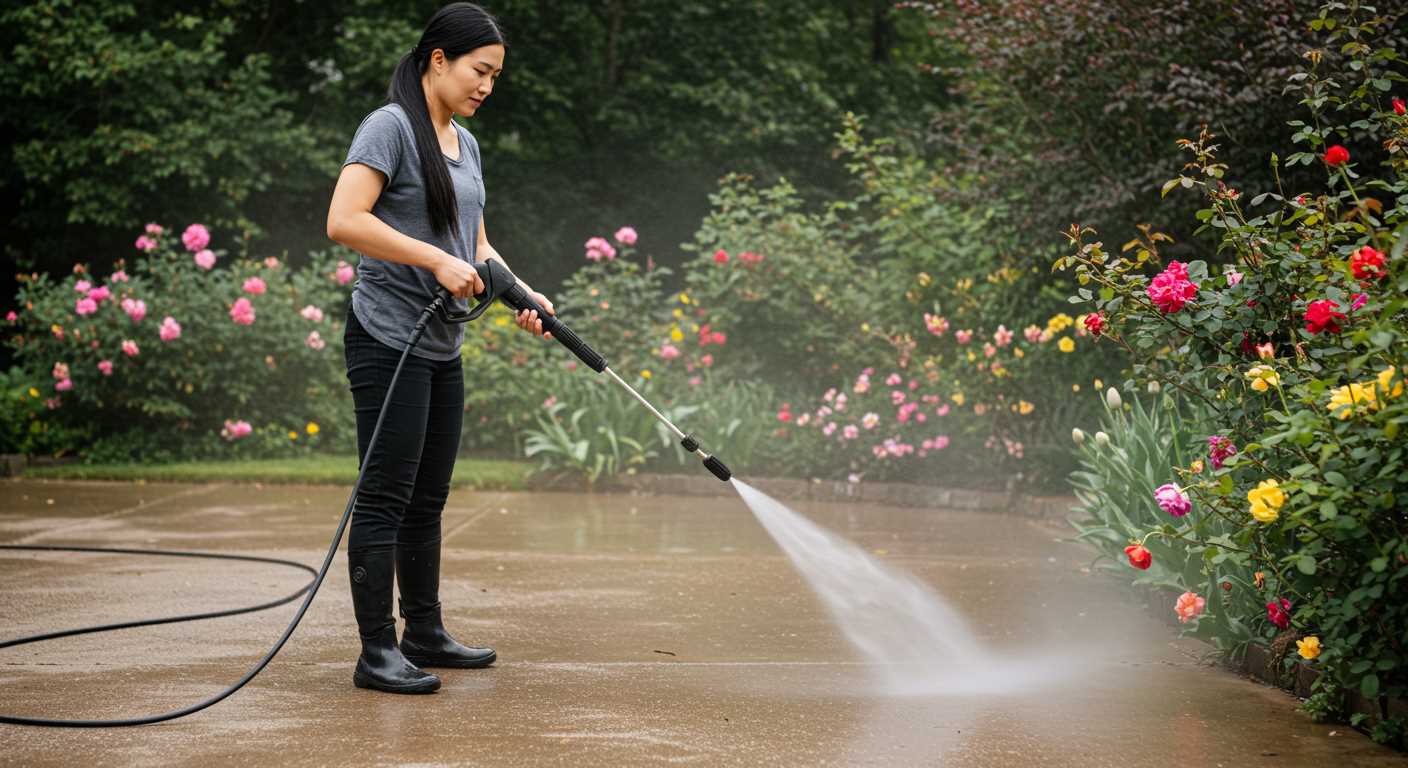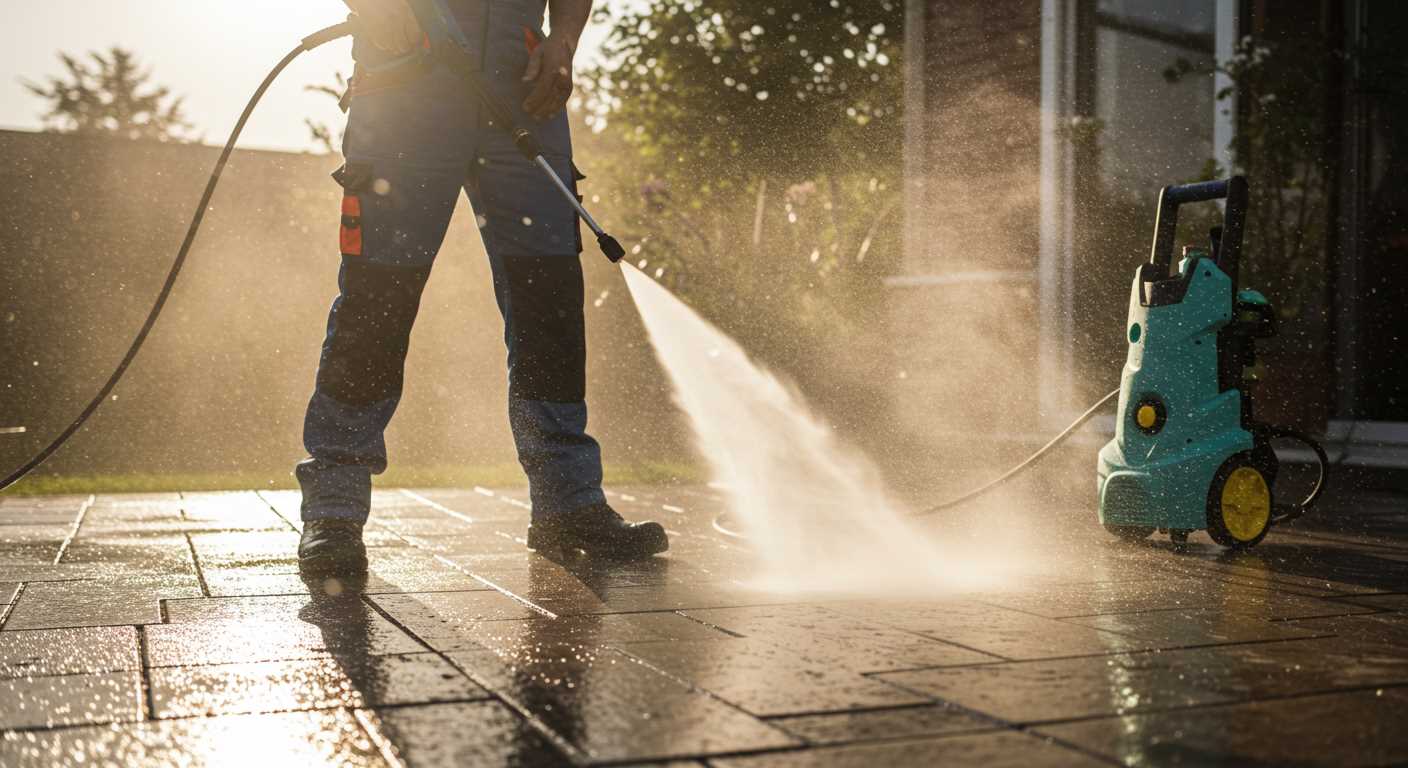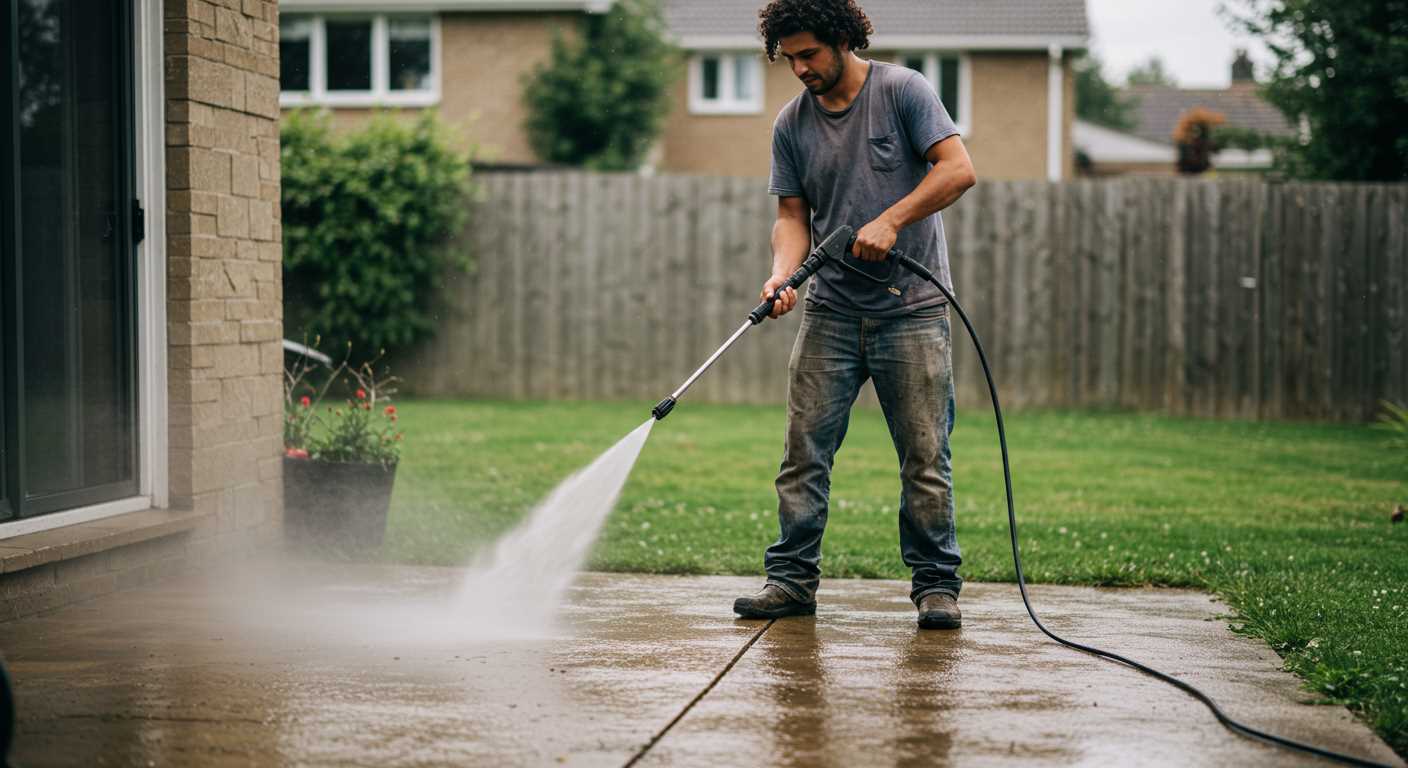



Begin by selecting the right nozzle for your cleaning apparatus; a 25-degree or 40-degree nozzle typically works best for outdoor surfaces. Adjust the water pressure according to the material’s durability; a medium setting often yields optimal results without damaging the structure. Test a small, inconspicuous area first to ensure the chosen setting doesn’t affect the surface adversely.
Preparation is key. Remove furniture, planters, and any obstacles from the area to create an unobstructed workspace. Clear away loose debris such as leaves and dirt using a broom or a leaf blower. For stubborn stains or mildew, consider applying a specialised cleaning solution before using your high-pressure device to enhance the outcome.
When starting the machine, maintain a distance of approximately 12 to 18 inches from the surface to prevent any potential harm. Movement should be methodical; work systematically in rows, overlapping each pass slightly for a thorough approach. Rinse off any cleaning agents appropriately to avoid residue that could attract dirt once more.
Finally, allow the area to dry completely before repositioning any furniture or accessories. Regular maintenance can prolong the life of these surfaces, so consider establishing a routine schedule for cleaning. This process not only rejuvenates the appearance but also contributes to overall longevity and safety. Invest time in these simple steps for impressive results.
Cleaning Process for Your Outdoor Surface
Prepare a mixture of water and a suitable detergent, ensuring it targets algae, moss, or dirt buildup. Use a garden sprayer to apply the solution evenly across the area. Allow it to sit for a minimum of 15 minutes to penetrate tough stains.
Pressure Settings and Technique
Adjust the equipment to a medium setting, typically around 1500 to 2000 PSI, to avoid damaging the surface. Maintain a distance of about two feet from the surface while maintaining a consistent sweeping motion. This prevents streaks and ensures thorough coverage.
- Work in small sections for easier management.
- Start from one end and methodically move to the other.
- Overlap each sweep slightly for even results.
Final Touches and Maintenance

After completing the wash, rinse the area using plain water, ensuring no detergent residue remains. Inspect for any missed spots and re-treat areas as necessary. After drying, consider sealing the surface to prevent future staining and make future cleanings easier.
Regular attention will keep your flooring looking fresh and inviting. Establish a maintenance schedule based on environmental factors like weather conditions and foot traffic levels.
Choosing the Right Pressure Washer for Your Outdoor Surface
For optimal results, selecting a unit with a minimum of 3000 PSI (pounds per square inch) is ideal. This level of pressure effectively tackles most stubborn stains and grime without damaging the surface beneath.
A machine with an adjustable pressure setting gives flexibility, allowing for less intense cleaning in more delicate areas. Look for models that include interchangeable nozzles, such as a 15-degree and a 25-degree nozzle, to customise the spray pattern and intensity for different types of dirt and debris.
Electric vs. Gas Models
Electric units are typically lighter and quieter, making them suitable for residential use. However, they tend to have lower PSI ratings, which may not handle tough jobs efficiently. On the other hand, gas models generally deliver more power and are ideal for larger tasks or heavily soiled surfaces, but they require more maintenance and can be cumbersome due to their weight and noise level.
Additional Features to Consider
Features such as hose length, built-in detergent tanks, and wheels for portability can enhance usability. A longer hose allows for extended reach without needing to move the machine frequently, while incorporating a detergent system streamlines the process.
Take time to evaluate these aspects, ensuring the selected apparatus aligns with your specific cleaning needs and preferences. Investing in the right equipment pays off in efficiency and effectiveness during the cleaning process.
Preparing Your Outdoor Surface for High-Pressure Service
Prior to initiating the high-pressure cleaning process, ensure to remove all furniture and accessories from the area. This allows for unobstructed access and protects your belongings from potential damage during cleaning.
Inspect the surface for loose debris and sediment. Use a broom or leaf blower to eliminate dirt, leaves, and other foreign matter. Address any weeds or grass growing in the joints by pulling them out, providing a clearer path for the subsequent washing.
Examine the entire area for significant stains or spills. It’s wise to treat these spots with a suitable pre-treatment solution, following the manufacturer’s instructions. Allow the product to sit for the recommended time before pressure application to enhance effectiveness.
Safety Measures and Preparations
Protective gear is mandatory. Equip yourself with safety goggles, gloves, and suitable footwear to safeguard against debris and splashes. Additionally, check the weather conditions; avoid high winds or rain that might affect the process.
Ensure that your water source is accessible, as well as an appropriate electric outlet or extension lead, depending on your chosen device’s requirements. Make sure all connections are secure to prevent interruptions during cleaning.
| Preparation Step | Description |
|---|---|
| Remove Furniture | Clear all items to protect them and facilitate the cleaning. |
| Clear Debris | Use a broom or blower to remove dirt and leaves. |
| Treat Stains | Apply pre-treatment solution to target stains effectively. |
| Wear Protective Gear | Use goggles, gloves, and sturdy shoes for safety. |
| Check Water Supply | Ensure a reliable water source is available for washing. |
By executing these preparations thoroughly, you set the stage for a successful and effective high-pressure clean. Proper groundwork ensures that your efforts yield optimal results, enhancing the overall appearance of the surface.
Selecting the Appropriate Cleaning Solution
Opt for a pH-neutral detergent specifically formulated for outdoor hard surfaces. These solutions effectively break down dirt, grime, and stains without damaging the material of your outdoor flooring. Look for eco-friendly options that minimise environmental impact while delivering powerful cleaning results.
For stubborn stains, such as oil or grease, consider a targeted degreaser. Apply it directly to the affected area and allow it to sit for a few minutes before washing away. Always ensure compatibility with the surface to avoid any unwanted reactions.
An alternative is a homemade mixture of vinegar and water for light cleaning tasks. This solution is mild but effective, helping to remove surface contaminants without harsh chemicals. Combine one part vinegar with three parts water, then apply it using a sprayer.
Before application, test any solution on a small, inconspicuous area to confirm it won’t cause damage. This step is crucial for preserving the appearance of your outdoor surfaces. Always follow the manufacturer’s instructions for any commercial product you choose to use.
Consider a pre-treatment phase if your surfaces are particularly dirty. Apply your chosen solution and allow it to dwell for 10-15 minutes before using your cleaning equipment. This will enhance the effectiveness of the wash, ensuring better results.
Selecting the right cleaning solution tailored to the specific needs of your surfaces can drastically improve the outcome. Always prioritise safety by wearing protective gear, especially when handling chemicals.
Techniques for Safely Using a Pressure Washer on Brick
Maintain a safe distance of at least 12 inches from the surface during operation. This prevents excessive wear and potential damage to the joints and overall integrity of the surfaces.
Optimal Nozzle Selections
- Utilise a wide fan nozzle (25-40 degrees) for gentler cleaning.
- For stubborn stains, a turbo nozzle can provide more concentrated power but should be used cautiously.
Pressure Settings and Movement

- Adjust the pressure to a lower setting (1500-2000 PSI) for delicate surfaces.
- Maintain a steady sweeping motion to avoid concentrated force on one spot, which can erode materials.
- Angle the nozzle to prevent water from penetrating the joints too deeply, which could weaken them over time.
It’s beneficial to pre-test an inconspicuous area to assess the effect and adjust your approach accordingly. This strategy ensures the chosen techniques are safe and effective for your specific situation.
Dealing with Stubborn Stains on Your Brick Patio
To tackle persistent discolourations, first determine their source. Grease and oil can be addressed with a mixture of baking soda and water. Apply this paste directly onto the stain and let it sit for around 30 minutes before rinsing with hot water.
For organic materials like moss or mildew, a solution of vinegar and water works wonders. Combine equal parts and spray on the affected areas. Allow it to bubble for about 15 minutes, then scrub with a stiff brush.
Heavy Stains and Special Treatments

For more resilient marks, consider oxygen bleach, a safer option compared to chlorine. Mix it according to package instructions and pour it over the stains, letting it activate for two hours before scrubbing and rinsing. This method preserves the surface while effectively lifting discolourations.
If rust is present, a dedicated rust remover will be your best bet. Follow the manufacturer’s guidelines to ensure safe application. After treatment, always thoroughly wash the area with plain water to avoid residue buildup.
Prevention Tips
To reduce future issues, consider sealing the surface after cleaning. A good sealant creates a protective barrier against stains, making routine maintenance simpler. Inspect the area regularly to catch any new stains early, ensuring your hardscape remains appealing and unharmed.
Post-Cleaning Care and Maintenance for Brick Patios
Once the surface is refreshed, it’s critical to ensure its longevity through appropriate upkeep. Begin by inspecting for any visible cracks or loose pieces; repairing these promptly prevents further damage. A suitable filler can be applied to maintain structural integrity.
Regularly sweeping away debris and leaves prevents organic growth and staining. Implementing a seasonal wash routine helps maintain aesthetics; a gentle scrub followed by rinsing keeps the appearance intact between deeper cleanings. Ideally, carry this out quarterly, especially before winter.
Sealing is another fundamental step post-wash. After allowing the surface to dry thoroughly, apply a high-quality sealant to protect against moisture and other environmental factors. This measure enhances resistance to stains and prolongs the life of the materials. Reapplication should occur every couple of years, or as recommended by the sealant manufacturer.
Pay attention to the surrounding landscape. Ensure that any runoff from flowerbeds or garden areas does not introduce unwanted pollutants or organic material onto your newly refreshed surface. Keeping plant life trimmed back can reduce debris accumulation and maintenance efforts.
Lastly, consider the footwear on the surface. Using rubber-soled shoes can help prevent scuff marks and minimise wear. Regularly evaluate high-traffic areas and take corrective measures to distribute foot traffic evenly, preserving the uniformity of the finish.








